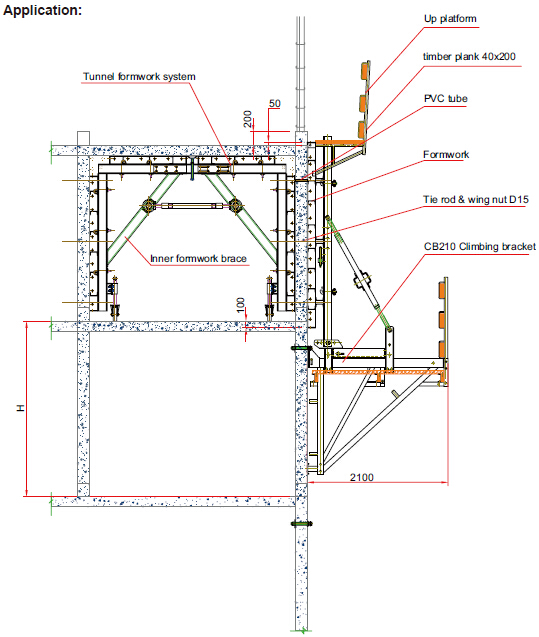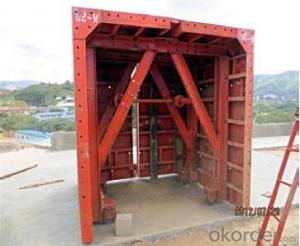Steel Tunnel for Formwork and Scaffolding Systems
- Loading Port:
- Tianjin
- Payment Terms:
- TT OR LC
- Min Order Qty:
- 50 m²
- Supply Capability:
- 1000 m²/month
OKorder Service Pledge
Quality Product, Order Online Tracking, Timely Delivery
OKorder Financial Service
Credit Rating, Credit Services, Credit Purchasing
You Might Also Like
Building Tunnel Formwork:
A compositional steel formwork system mainly used in the building which has regular structure
without beams, the excellent formwork system can make the integral pouring for the wall & slab
easily achieved.
Characteristics:
◆ High stiffness, make perfect shape for concrete.
◆ Easy operation, save labor and force.
◆ Fast forming, repeatedly turnover.

- Q:Is steel formwork suitable for both residential and commercial construction projects?
- Yes, steel formwork is suitable for both residential and commercial construction projects. Steel formwork provides numerous advantages such as durability, strength, and reusability, making it an ideal choice for various construction projects. It can withstand the pressure exerted by concrete, ensuring a high-quality finish. Steel formwork also allows for faster construction as it can be easily assembled and disassembled, making it suitable for projects with tight deadlines. Additionally, steel formwork can be customized to meet specific project requirements, ensuring precise and accurate construction. Overall, steel formwork is a versatile and reliable solution for both residential and commercial construction projects.
- Q:Can steel formwork be used for complex geometric designs?
- Yes, steel formwork can be used for complex geometric designs. Its strength and durability allow for intricate shapes and patterns to be created, providing flexibility in design and construction.
- Q:Are there any disadvantages to using steel formwork?
- Yes, there are disadvantages to using steel formwork. One major disadvantage is the high initial cost. Steel formwork is more expensive to purchase or rent compared to other types of formwork, such as wood or plastic. This can be a significant factor for smaller construction projects or for contractors on a tight budget. Another drawback is the weight of steel formwork. Steel is much heavier than other materials, which can make it more difficult to handle and transport. This can increase labor costs and require more manpower to set up and dismantle the formwork. Additionally, steel formwork requires skilled labor to assemble and dismantle properly. It is important to have experienced workers who understand the correct procedures and techniques to ensure the safety and stability of the formwork. This can add to the overall project cost and time. Steel formwork is also prone to corrosion if not properly maintained. Exposure to moisture and chemicals can cause rust and deterioration, which can compromise the integrity of the formwork and pose safety risks. Regular inspections and maintenance are necessary to prevent and address corrosion issues. Lastly, steel formwork is not as flexible or adjustable as other types of formwork. Once it is fabricated, it is difficult to modify or adjust the formwork to accommodate changes in design or dimensions. This lack of flexibility can be a disadvantage in projects where modifications or adjustments are frequently needed. Overall, while steel formwork offers advantages such as durability and reusability, it also has disadvantages that need to be considered when choosing the appropriate formwork for a construction project.
- Q:How does steel formwork accommodate for different concrete curing methods?
- Due to its durability, flexibility, and ease of use, steel formwork is a versatile construction material that can accommodate various concrete curing methods. To begin with, different curing methods can be employed with steel formwork, including wet curing, dry curing, and accelerated curing. Wet curing involves maintaining the concrete's moisture and hydration for a specific period, while dry curing involves controlling the concrete's environment with low humidity. On the other hand, accelerated curing utilizes external heat sources to expedite the curing process. Steel formwork is particularly suitable for wet curing as it effectively retains moisture and prevents water loss from the concrete. The tightly fitted steel panels create a watertight enclosure that minimizes evaporation. This ensures that the concrete remains adequately hydrated during curing, promoting proper strength development and minimizing the risk of cracking or shrinkage. Likewise, steel formwork easily accommodates dry curing methods. The steel panels act as a barrier between the concrete and the surrounding environment, allowing precise control of humidity levels. This is especially beneficial in hot or dry climates, where maintaining a low humidity environment is critical for preventing premature moisture loss and ensuring proper curing. Furthermore, steel formwork is compatible with accelerated curing techniques. Its ability to withstand high temperatures makes it suitable for applications where external heat sources are used to expedite the curing process. The steel panels can withstand elevated temperatures without warping or compromising their structural integrity. Additionally, steel formwork can be easily adjusted or modified to meet specific curing requirements. The modular nature of steel formwork allows for flexibility in design and construction. By rearranging or adding steel panels, the formwork can be customized to create different shapes, sizes, or configurations. This flexibility is particularly advantageous when dealing with complex or unique concrete structures. In summary, steel formwork is a reliable choice for accommodating various concrete curing methods. Its durability, flexibility, and adaptability make it the preferred option in construction projects that require precise control over the curing process to achieve optimal concrete strength and quality.
- Q:Can steel formwork be used for both residential and commercial renovations?
- Yes, steel formwork can be used for both residential and commercial renovations. Steel formwork is a versatile and durable option that can withstand the demands of various construction projects, making it suitable for both residential and commercial renovations. Its strength and stability make it ideal for creating concrete structures in both types of buildings.
- Q:What are the fire resistance properties of steel formwork?
- Steel formwork has excellent fire resistance properties due to its high melting point and low thermal conductivity. It is able to withstand high temperatures for extended periods of time without losing its structural integrity, making it a safe and reliable choice for construction projects in fire-prone areas.
- Q:Are there any specific design considerations for steel formwork systems?
- Yes, there are several specific design considerations for steel formwork systems. These include factors such as the load-bearing capacity of the system, its stability and rigidity, ease of assembly and disassembly, durability, corrosion resistance, and adaptability to different project requirements. Additionally, the design should incorporate safety features like non-slip surfaces, secure connections, and proper bracing to ensure worker safety during construction activities.
- Q:How does steel formwork contribute to the strength and stability of a concrete structure?
- Steel formwork is a critical component in the construction of concrete structures as it plays a crucial role in enhancing their strength and stability. One of the key ways in which steel formwork contributes to this is by providing a robust framework for the concrete to be poured into and cured. The steel formwork acts as a mold or a template that holds the liquid concrete in place until it solidifies. This ensures that the concrete takes the desired shape and form, resulting in a structurally sound and stable structure. Furthermore, steel formwork provides support and reinforcement to the concrete during the curing process. As the concrete hardens, it exerts pressure on the formwork. The high tensile strength of steel allows it to withstand and distribute these forces evenly, thereby preventing any distortion or collapse of the structure. This is particularly important in the case of large-scale or complex structures where the concrete needs to be supported over extended periods. In addition, steel formwork facilitates the proper alignment and leveling of the concrete during the construction process. The rigid nature of steel ensures that the formwork remains in place and maintains its shape, resulting in accurate dimensions and a uniform finish. This contributes to the overall strength and stability of the concrete structure by eliminating any irregularities or weaknesses that may arise from inaccuracies in the formwork. Moreover, steel formwork can be easily assembled and disassembled, allowing for efficient construction processes. This flexibility enables faster construction timelines, minimizing the exposure of the concrete to external elements and reducing the risk of structural damage. The ability to reuse steel formwork also makes it a cost-effective solution for multiple construction projects. Overall, the use of steel formwork significantly enhances the strength and stability of concrete structures by providing a sturdy framework, supporting the curing process, ensuring accurate alignment, and facilitating efficient construction practices. Its durability, strength, and versatility make it an essential component in the construction industry, contributing to the creation of safe and reliable concrete structures.
- Q:Are there any specialized tools or equipment required for steel formwork?
- Specialized tools and equipment are necessary for steel formwork. Some commonly used tools are as follows: 1. To secure the steel formwork panels together and maintain stability and alignment, formwork clamps are utilized. 2. Formwork ties are employed to hold the formwork panels in place and prevent any movement while concrete is being poured and cured. 3. Formwork brackets are utilized to evenly distribute the load and provide support to the formwork panels. 4. Formwork shuttering magnets are utilized to securely hold the formwork panels in place, establishing a strong connection. 5. Formwork jacks are utilized to adjust the height of the formwork panels, enabling precise leveling and alignment. 6. Formwork hangers are employed to suspend the formwork panels from overhead structures, enhancing stability and support. 7. Formwork props are utilized to vertically support the formwork panels, ensuring their position during the concrete pouring process. 8. Formwork vibrators are used to eliminate air bubbles and guarantee proper compaction of the concrete within the formwork. Proper and appropriate use of these specialized tools and equipment is crucial to maintain the structural integrity and quality of the steel formwork.
- Q:How does steel formwork affect the overall construction waste generation?
- Steel formwork can significantly reduce overall construction waste generation. Unlike traditional timber formwork, steel formwork is reusable, durable, and can be used for multiple construction projects. This means that less formwork material needs to be discarded and replaced after each use, reducing the amount of waste generated. Additionally, steel formwork is easier to clean and maintain, further reducing wastage. Overall, the use of steel formwork in construction projects helps minimize waste generation and promotes sustainable construction practices.
1. Manufacturer Overview |
|
|---|---|
| Location | |
| Year Established | |
| Annual Output Value | |
| Main Markets | |
| Company Certifications | |
2. Manufacturer Certificates |
|
|---|---|
| a) Certification Name | |
| Range | |
| Reference | |
| Validity Period | |
3. Manufacturer Capability |
|
|---|---|
| a)Trade Capacity | |
| Nearest Port | |
| Export Percentage | |
| No.of Employees in Trade Department | |
| Language Spoken: | |
| b)Factory Information | |
| Factory Size: | |
| No. of Production Lines | |
| Contract Manufacturing | |
| Product Price Range | |
Send your message to us
Steel Tunnel for Formwork and Scaffolding Systems
- Loading Port:
- Tianjin
- Payment Terms:
- TT OR LC
- Min Order Qty:
- 50 m²
- Supply Capability:
- 1000 m²/month
OKorder Service Pledge
Quality Product, Order Online Tracking, Timely Delivery
OKorder Financial Service
Credit Rating, Credit Services, Credit Purchasing
Similar products
New products
Hot products
Related keywords






















